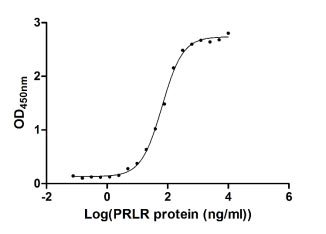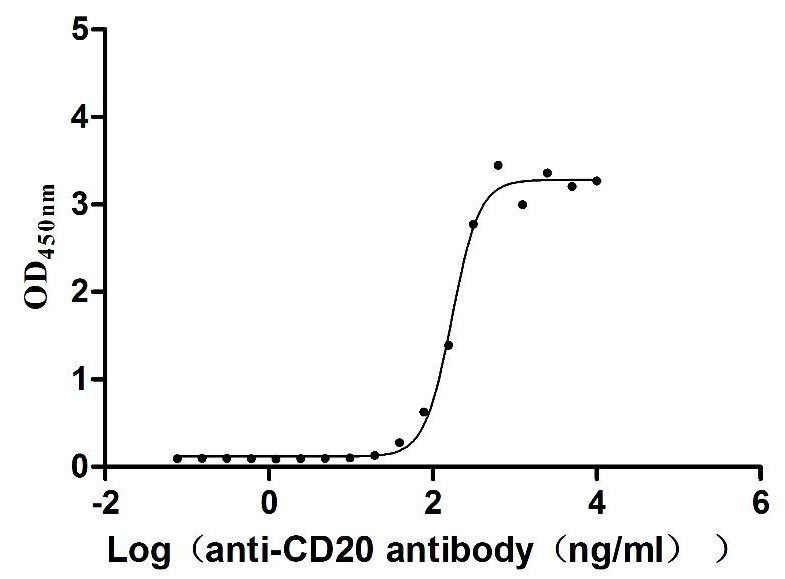Recombinant Rat Egl nine homolog 3 (Egln3)
-
货号:CSB-YP733831RA
-
规格:
-
来源:Yeast
-
其他:
-
货号:CSB-EP733831RA
-
规格:
-
来源:E.coli
-
其他:
-
货号:CSB-EP733831RA-B
-
规格:
-
来源:E.coli
-
共轭:Avi-tag Biotinylated
E. coli biotin ligase (BirA) is highly specific in covalently attaching biotin to the 15 amino acid AviTag peptide. This recombinant protein was biotinylated in vivo by AviTag-BirA technology, which method is BriA catalyzes amide linkage between the biotin and the specific lysine of the AviTag.
-
其他:
-
货号:CSB-BP733831RA
-
规格:
-
来源:Baculovirus
-
其他:
-
货号:CSB-MP733831RA
-
规格:
-
来源:Mammalian cell
-
其他:
产品详情
-
纯度:>85% (SDS-PAGE)
-
基因名:
-
Uniprot No.:
-
别名:Egln3; Sm20Egl nine homolog 3; EC 1.14.11.29; Hypoxia-inducible factor prolyl hydroxylase 3; HIF-PH3; HIF-prolyl hydroxylase 3; HPH-3; Prolyl hydroxylase domain-containing protein 3; PHD3; SM-20
-
种属:Rattus norvegicus (Rat)
-
蛋白长度:full length protein
-
表达区域:1-239
-
氨基酸序列MPLGHIMRLD LEKIALEYIV PCLHEVGFCY LDNFLGEVVG DCVLERVKQL HYNGALRDGQ LAGPRAGVSK RHLRGDQITW IGGNEEGCEA INFLLSLIDR LVLYCGSRLG KYYVKERSKA MVACYPGNGT GYVRHVDNPN GDGRCITCIY YLNKNWDAKL HGGVLRIFPE GKSFVADVEP IFDRLLFSWS DRRNPHEVQP SYATRYAMTV WYFDAEERAE AKKKFRNLTR KTESALAKD
-
蛋白标签:Tag type will be determined during the manufacturing process.
The tag type will be determined during production process. If you have specified tag type, please tell us and we will develop the specified tag preferentially. -
产品提供形式:Lyophilized powder
Note: We will preferentially ship the format that we have in stock, however, if you have any special requirement for the format, please remark your requirement when placing the order, we will prepare according to your demand. -
复溶:We recommend that this vial be briefly centrifuged prior to opening to bring the contents to the bottom. Please reconstitute protein in deionized sterile water to a concentration of 0.1-1.0 mg/mL.We recommend to add 5-50% of glycerol (final concentration) and aliquot for long-term storage at -20℃/-80℃. Our default final concentration of glycerol is 50%. Customers could use it as reference.
-
储存条件:Store at -20°C/-80°C upon receipt, aliquoting is necessary for mutiple use. Avoid repeated freeze-thaw cycles.
-
保质期:The shelf life is related to many factors, storage state, buffer ingredients, storage temperature and the stability of the protein itself.
Generally, the shelf life of liquid form is 6 months at -20°C/-80°C. The shelf life of lyophilized form is 12 months at -20°C/-80°C. -
货期:Delivery time may differ from different purchasing way or location, please kindly consult your local distributors for specific delivery time.Note: All of our proteins are default shipped with normal blue ice packs, if you request to ship with dry ice, please communicate with us in advance and extra fees will be charged.
-
注意事项:Repeated freezing and thawing is not recommended. Store working aliquots at 4°C for up to one week.
-
Datasheet :Please contact us to get it.
靶点详情
-
功能:Prolyl hydroxylase that mediates hydroxylation of proline residues in target proteins, such as PKM, TELO2, ATF4 and HIF1A. Target proteins are preferentially recognized via a LXXLAP motif. Cellular oxygen sensor that catalyzes, under normoxic conditions, the post-translational formation of 4-hydroxyproline in hypoxia-inducible factor (HIF) alpha proteins. Hydroxylates a specific proline found in each of the oxygen-dependent degradation (ODD) domains (N-terminal, NODD, and C-terminal, CODD) of HIF1A. Also hydroxylates HIF2A. Has a preference for the CODD site for both HIF1A and HIF2A. Hydroxylation on the NODD site by EGLN3 appears to require prior hydroxylation on the CODD site. Hydroxylated HIFs are then targeted for proteasomal degradation via the von Hippel-Lindau ubiquitination complex. Under hypoxic conditions, the hydroxylation reaction is attenuated allowing HIFs to escape degradation resulting in their translocation to the nucleus, heterodimerization with HIF1B, and increased expression of hypoxy-inducible genes. ELGN3 is the most important isozyme in limiting physiological activation of HIFs (particularly HIF2A) in hypoxia. Also hydroxylates PKM in hypoxia, limiting glycolysis. Under normoxia, hydroxylates and regulates the stability of ADRB2. Regulator of cardiomyocyte and neuronal apoptosis. In cardiomyocytes, inhibits the anti-apoptotic effect of BCL2 by disrupting the BAX-BCL2 complex. In neurons, has a NGF-induced proapoptotic effect, probably through regulating CASP3 activity. Also essential for hypoxic regulation of neutrophilic inflammation. Plays a crucial role in DNA damage response (DDR) by hydroxylating TELO2, promoting its interaction with ATR which is required for activation of the ATR/CHK1/p53 pathway. Also mediates hydroxylation of ATF4, leading to decreased protein stability of ATF4.
-
基因功能参考文献:
- 24 h after HI, there was a significant increase in PHD3 protein and an increase of HIF-1alpha compared to controls PMID: 26108712
- depletion of PHD3 leads to increased stabilization of HIF-1alpha and inhibition of DNA damage response, both of which may contribute to the cardioprotective effect seen with depletion of PHD3. PMID: 25633836
- Prolyl hydroxylase 3 (PHD3) modulates catabolic effects of tumor necrosis factor-alpha (TNF-alpha) on cells of the nucleus pulposus through co-activation of nuclear factor kappaB (NF-kappaB)/p65 signaling. PMID: 22948157
- Egln3 suppresses glioma progression PMID: 22905089
- PHD3 upregulation may be partially responsible for DOX-induced cardiomyocyte apoptosis via its interaction with Bcl-2. PMID: 20849813
- PHD2 and PHD3 are inducible by hypoxia, possibly via elevated HIF-1alpha, in pulmonary hypertension. PMID: 17129494
- Angiotensin II's antiproliferative effects mediated through AT2-receptors depend on down-regulation of this protein PMID: 12379765
- Induction of SM-20 expression appears to affect both the amount and subcellular localization of cytochrome c in PC12 cells PMID: 12675908
- identified the three forms of prolyl hydroxylase in rats and demonstrated that a period of hypoxia selectively increases expression of PHD-2 mRNAs levels PMID: 12876291
- Decrease in PHD3 expression level is associated with ischemia. PMID: 19349364
显示更多
收起更多
-
亚细胞定位:Nucleus. Cytoplasm.
-
组织特异性:Highly expressed in vascular smooth muscle. Moderately expressed in esophagus, stomach, small bowel and aorta. Low levels in tail and kidney. Expression also in pheochromocytoma cell line PC-12.
-
数据库链接:
KEGG: rno:54702
STRING: 10116.ENSRNOP00000007219
UniGene: Rn.10994
Most popular with customers
-
Recombinant Human Somatotropin (GH1) (Active)
Express system: Mammalian cell
Species: Homo sapiens (Human)
-
Recombinant Dog B-lymphocyte antigen CD20 (MS4A1)-VLPs (Active)
Express system: Mammalian cell
Species: Canis lupus familiaris (Dog) (Canis familiaris)
-
Recombinant Macaca fascicularis lymphocyte antigen 6 family member G6D (LY6G6D) (Active)
Express system: Yeast
Species: Macaca fascicularis (Crab-eating macaque) (Cynomolgus monkey)
-
Recombinant Human Alkaline phosphatase, germ cell type (ALPG) (Active)
Express system: Mammalian cell
Species: Homo sapiens (Human)
-
Recombinant Human C-type lectin domain family 4 member C (CLEC4C), partial (Active)
Express system: Mammalian cell
Species: Homo sapiens (Human)
-
Recombinant Human Transferrin receptor protein 1 (TFRC), partial (Active)
Express system: Mammalian cell
Species: Homo sapiens (Human)
-
Recombinant Human Oncostatin-M (OSM), partial (Active)
Express system: Mammalian cell
Species: Homo sapiens (Human)
-
Recombinant Human Cadherin-6(CDH6),partial (Active)
Express system: Mammalian cell
Species: Homo sapiens (Human)




















